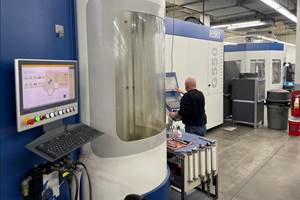Hexagon's Radan Helps Shop Meet Ventilator Production Demand
Hexagon’s Radan CAD/CAM software helped Bolger Engineering meet a massive increase in ventilator part demand during the COVID-19 pandemic.
Share

Hexagon Manufacturing Intelligence’s Radan CAD/CAM software has helped custom enclosure and hardware specialist to meet production demands for ventilator parts during the COVID-19 pandemic.
At the start of the pandemic, Bolger’s long-standing customer asked the shop to produce enough parts that Medtronic could make 500 ventilators per week, whereas Bolger had previously produced parts for 100 ventilators per week.
Bolger brought on 35 more employees and changed shift patterns to a 24/5 operating model, but Bolger sales manager Paul Collins also says the shop’s Radan CAD/CAM software was key to handling this production increase.
“We use Radan to program both our Trumpf punching machines and Trumpf laser cutter, so with over 18,000 components a week to produce for these ventilators alone, we knew material utilization and program optimization was going to be crucial to meet such a significant demand,” says Collins. “Our programmers typically take a 3D model or DXF drawing and import it into Radan to tool the part for either the punch or laser machines, depending on material thickness and complexity of the profile. They then nest and program the machine where Radan gives the best sheet utilization. This is hugely important, as more often than not, material is the largest percentage of a job’s costs.”
Radan software allows the user to optimize manufacturing nests and profile components within extremely tight tolerances of +/- 0.2 mm. With some components’ designs including 14 bends per part, correctly calculating bend allowances was vital for later assembly.
The CAD software also allowed Bolger to support a long-standing customer in the food and beverage sector who required a hands-free hot water delivery solution to meet COVID-19 health requirements. Radan allowed Bolger to swiftly produce a prototype, and the project moved from concept to full production within two weeks.
Related Content
-
Supercritical Success for Medical Machining
High-pressure carbon dioxide coolant can dramatically improve the production rate of titanium parts while leaving no residue — an excellent fit for medical machining.
-
Kyzen Solvents Provide Ease of Cleaning for Medical Parts
The Metalnox line of solvent products are designed to improve reliability and increase the ease of cleaning in vacuum and vapor degreasing processes.
-
German Project Yields Three New Medical Machining Processes
Trends to Watch at IMTS: Recent research has resulted in a new mix of high-speed turn whirl milling, polygon turning and rotational turning for manufacturing medical bone screws and out-of-round nails.
Related Content
Supercritical Success for Medical Machining
High-pressure carbon dioxide coolant can dramatically improve the production rate of titanium parts while leaving no residue — an excellent fit for medical machining.
Read MoreKyzen Solvents Provide Ease of Cleaning for Medical Parts
The Metalnox line of solvent products are designed to improve reliability and increase the ease of cleaning in vacuum and vapor degreasing processes.
Read MoreGerman Project Yields Three New Medical Machining Processes
Trends to Watch at IMTS: Recent research has resulted in a new mix of high-speed turn whirl milling, polygon turning and rotational turning for manufacturing medical bone screws and out-of-round nails.
Read MoreFive-Axis Turnkey Machine Halves Medical Shop’s Cycle Times
Horizontal five-axis machines cut cycle times in half at ARCH Medical Solutions – Newtown. But its leadership gives equal credit to a surprising factor: the OEM’s service department.
Read MoreRead Next
AMRs Are Moving Into Manufacturing: 4 Considerations for Implementation
AMRs can provide a flexible, easy-to-use automation platform so long as manufacturers choose a suitable task and prepare their facilities.
Read MoreMachine Shop MBA
Making Chips and Modern Machine Shop are teaming up for a new podcast series called Machine Shop MBA—designed to help manufacturers measure their success against the industry’s best. Through the lens of the Top Shops benchmarking program, the series explores the KPIs that set high-performing shops apart, from machine utilization and first-pass yield to employee engagement and revenue per employee.
Read More





